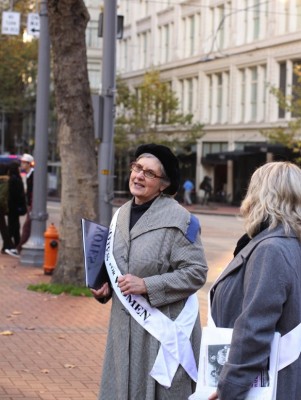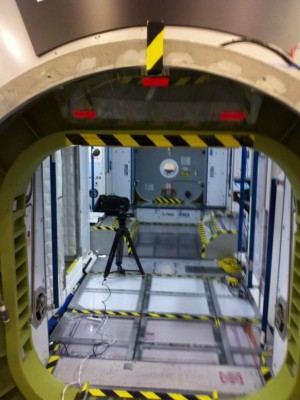Ask a consulting historian: Jan Dilg
08 April 2016 – editors
methods, entrepreneurialism, consultants, employment, Ask a Practitioner, Ask a Consulting Historian

Jan Dilg leads a women’s suffrage walking tour in Portland. Photo credit: Jan Dilg
Jan Dilg is an independent historian and the principal of HistoryBuilt, a historical consulting firm. She works with public agencies, non-profits, and historical organizations on a variety of public history programs, events, and products.
How did you first become involved in historical consulting?
I went back to school as an older student. I wanted to finish my degree and I found myself drawn to the history courses I was taking, so I decided to pursue history as my major. I did both my undergraduate and master’s work at Portland State University. While I was in school, I secured a Rose Tucker Fellowship at the Oregon Historical Society. I got started consulting because I wanted to get keep going in the field of history, even after the fellowship at the historical society had ended. I talked to other consulting historians and based on that, I put together a small consulting business.
How did you handle the business aspects of starting consulting work?
I eased into it very haphazardly. I did not incorporate initially. I didn’t find that to be an issue until I was contacted about working on a project with some city agencies and not being incorporated became a make-or-break issue. That spurred me to leap into stricter business practices.
Has History Built always been your company name or is it a recent rebranding?
It was a more recent rebranding. Part of that came about when I decided I needed to have a bit more of a presence. I would say that the majority of my business comes from referrals, but I still wanted more of a presence. I decided to build a brand and I had a website built. I think that’s been very effective.

Jan’s oral history recording equipment set up in the Harmony pod of the International Space Center mockup at the Johnson Space Center waiting for astronaut and Oregon State University alumnus Don Petit to arrive for his interview. Photo credit: Jan Dilg
Describe your work and a few recent projects.
In the last few years, I’ve been doing a lot of oral history. It’s always been a component of my business, but my work is about 75 percent oral history. I’m working on three major projects. One that I’ve been involved with since I started consulting is the US District Court of Oregon oral history project. They have their own historical society and they’ve been doing an ongoing oral history project, in collaboration with the Oregon Historical Society, since the mid-1980s. I’ve continued to manage that project, as well as conduct oral histories with federal judges, members of the federal court system, and probation officers. We collect and archive oral histories with people who make the federal courts function.
I’m almost finished with a project with Oregon State University that took about three years. It was an oral history project to document the university’s history in anticipation of their sesquicentennial anniversary that’s coming up in a few years. I interviewed alumni, administrators, faculty, and staff on a wide variety of subjects, from someone who graduated from OSU in 1939 to someone who retired last year.
I’m also doing a project with the Oregon State Capitol Foundation, which is a group that tries to highlight the history of the state capitol building and the people in the legislature. They’re trying to revive a previous oral history project. We’ve been interviewing some people who held elected positions of various kinds.
Do you collaborate with other professionals on projects?
Absolutely. One project that I did a couple of years ago was a park, Dawson Park, that underwent massive renovations that included integrating history into the design. In that, I worked with a landscape architecture firm and a graphic design firm. That was a pretty interesting and unique collaboration.

Jan Dilg at Dawson Park in Portland. Photo credit: Jan Dilg
It sounds like the majority of your clients are in the public sector. Do you have to bid on projects?
Most of my projects come from referrals, but I still have to put together bids to outline costs. In a couple of projects, I’ve been the person responsible for contacting archives and knowing what any image reproduction and usage costs will be up front. And those costs become part of the bid, so I need to put enough money into the budget to cover those costs.
When you’re putting together a budget for a project, are you working on primarily an hourly fee or a project fee?
It varies. With oral histories, I’ve done that enough that I’m pretty clear what the time requirements are going to be, so I give a per recorded hour price. If it’s something that’s pretty unique, I either add an hourly component or add overhead that would cover quirks that may come up that aren’t obvious because it’s a one-off project. One important skill I’ve learned over the years is how to recognize when a client is expanding the original scope of work, and to negotiate additional compensation to cover new, additional work. Not always an easy discussion to have, but essential to running a successful consulting business.
Is there such a thing as a typical day at work for you?
I would say typical in the sense there’s a portion that includes correspondence and communication and the other portion that includes public history work, whether that’s doing research for an upcoming oral history or research in an archive for some project. Each day varies some, but I’d say each has sort of a framework to it.
What are some of the challenges as well as some of the rewards of consulting work?
The challenge is never really knowing whether another project is going to come along. There isn’t a lot of repeat business. As I start to get towards the end of a project, I feel anxiety about what I will be doing next. I think the other challenge is managing the business part of it. What keeps me really engaged is that I can, to a certain degree, control what I work on. I generally do projects that are of interest to me. I also like the independence and the flexibility–I can work ten hours one day and then the next day do something during regular work hours that I wouldn’t necessarily be able to do if I worked in an office.
~ This post is part of our “Ask a Consulting Historian” series, brought to you by the NCPH Consultants Committee. Follow the Consultants Committee on Twitter at @NCPHconsultants. You can find more “Ask a Practitioner” posts here.



